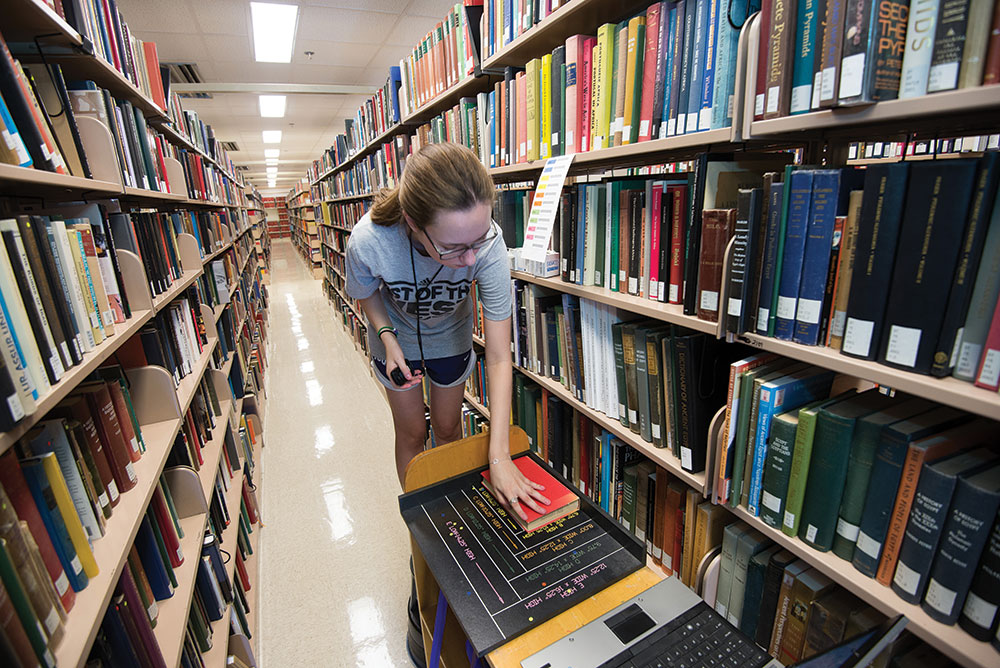Mary Couts Burnett Library prepares for major renovation
Selecting and organizing 800,000 volumes for an off-campus move has the staff of the Mary Couts Burnett Library measuring every monograph, journal and tome.

Freshman Sara Davy measures TCU’s tomes using a sizing template or jig to prepare for the Mary Couts Burnett Library massive book migration. Over the winter, it will move 800,000 titles to an off-site storage facility. (Photography by Glen E. Ellman)
Mary Couts Burnett Library prepares for major renovation
Selecting and organizing 800,000 volumes for an off-campus move has the staff of the Mary Couts Burnett Library measuring every monograph, journal and tome.
Moving day is months away, but planning for the Mary Couts Burnett Library’s big book migration started long ago.
To make room for its coming renovation, the library will begin packing up and shipping about two-thirds of its holdings — some 500,000 monographs plus another 300,000 bound journals — to an off-site storage facility a few miles from campus. With a professional mover’s help, the process will start in early January and be complete by mid-March.
Patrons need not worry — all the materials will be accessible to faculty and students daily through a request/retrieval program.
Off-site items will be contained in a high-density storage system called the Harvard Model, in which books are shelved in open cardboard box trays based on size rather than subject matter or call number.
“The object is to maximize space,” says James Lutz, director of library administrative services, who is overseeing the move. “Thanks to compact shelving and the store-by-size model, those 800,000 volumes will be stored in a space one-seventh to one-tenth the space they take up here.”

In order to organize items most compactly, the library is measuring nearly every book’s dimensions with a sizing template or jig. Based on its width and height, a book is marked with a colored dot on its spine. When it’s time for the move, all the similar-sized items with the same color dot will be packed in trays together.
“Our favorite phrase is ‘bigger is better,’” says Beth Callahan, library specialist in the government information department, who is managing the collection of depository items with the help of more than 30 students. “If a book can’t fit in the box because it was sorted as undersized, then we’ll have to go back and fix that. Accuracy is essential.”
Books also are getting a label with a barcode on the front cover, which will correspond with barcodes on the box tray, the shelf section and shelf row. The three codes will help a retriever pinpoint the item quickly and perform a pull of requested items with maximum efficiency.
“Essentially, we’ll have a geographic map of where any given item is,” Lutz says.
Which books stay and which go? That process started last spring when library subject matter specialists developed a formula based on circulation to winnow the number of holdings. If an item had been checked out or taken off the shelf to be browsed or photocopied a few times, it was initially eligible to stay. But subject librarians may override that.

“They can look in the record and see that the 2009 volume was scheduled to stay, but it has only been checked out only once. That doesn’t constitute good use, so it should go,” Lutz says.
The library also hosted a series of town halls for faculty to weigh in on which books are essential to keep on-site.
Now that portions of the library’s collection are dotted, subject librarians are scanning the shelf visually to make adjustments.
“They can say that this book isn’t dotted, but I really think it can go off-site,” Callahan says. “Or this is a seminal work. It needs to stay.”
With a temperature- and humidity-controlled warehouse, the off-site location actually will keep books and items better preserved, Lutz said.
An online browsing system will include book covers, tables of content and indices to replicate the senesation of scanning the stacks, he said.
On the Web:
TCU360 story on the library’s planned move

Your comments are welcome
Comments
Related Reading:
Campus News: Alma Matters
TCU’s Library Celebrates a Century
Uncover hidden gems of the academic hub, from vintage mechanics to modern masterpieces.
Campus News: Alma Matters
Infographic: TCU’s Shared Values
The Board of Trustees adopted four TCU values after considering input from more than 4,000 constituents.